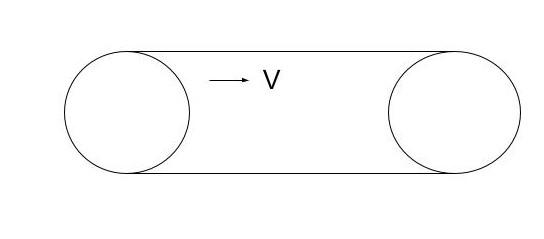
The tractor is moving with velocity of 6km/hr. Mass of belt is 720gm .KE of belt is

A. $4\,J$
B. $1\,J$
C. $2\,J$
D. $6\,J$

Answer
503.7k+ views
Hint: The kinetic energy of an object is the energy it has due to its motion in physics. It is the amount of work necessary to accelerate a body of a given mass from rest to a given velocity. If the body's speed varies, the kinetic energy gained during acceleration is retained. As the body decelerates from its current speed to a state of rest, it does the same amount of work.
Complete step-by-step solution:
In classical mechanics, the mass and speed of a point object (an object so small that its mass can be said to exist at one point) or a non-rotating rigid body determine its kinetic energy. The product of mass and speed squared equals half of the kinetic energy. In form of a formula:
$K.E = \dfrac{1}{2} \times m \times {v^2}$
Where \[m\] is the mass and \[v\] is the body's speed (or velocity). Mass is measured in kilogrammes, speed in metres per second, and kinetic energy is measured in joules in SI units.
Now let us come to the problem:
Given:
Mass of the belt is $m = 720\,gm$
Converting $m$ from $gm$ to $kg$$ = \dfrac{{720}}{{1000}} = 0.72\,kg$
$\therefore m = 0.72\,kg$
Velocity of tractor is $v = 6km/hr.$
$v = 6 \times \dfrac{5}{{18}}m/s$
$v = \dfrac{5}{3}\,m/s$
$K.E = \dfrac{1}{2} \times m \times {v^2}$
$K.E = \dfrac{1}{2} \times 0.72 \times {\left( {\dfrac{5}{3}} \right)^2}$
$K.E = 1\,J$
So option $(2)$ is correct.
Note:Let us know something more about Kinetic energy. Windmills are an excellent example of kinetic energy applications. When wind (moving air) strikes the blades of a windmill, it causes them to rotate, resulting in the production of electricity.
Complete step-by-step solution:
In classical mechanics, the mass and speed of a point object (an object so small that its mass can be said to exist at one point) or a non-rotating rigid body determine its kinetic energy. The product of mass and speed squared equals half of the kinetic energy. In form of a formula:
$K.E = \dfrac{1}{2} \times m \times {v^2}$
Where \[m\] is the mass and \[v\] is the body's speed (or velocity). Mass is measured in kilogrammes, speed in metres per second, and kinetic energy is measured in joules in SI units.
Now let us come to the problem:
Given:
Mass of the belt is $m = 720\,gm$
Converting $m$ from $gm$ to $kg$$ = \dfrac{{720}}{{1000}} = 0.72\,kg$
$\therefore m = 0.72\,kg$
Velocity of tractor is $v = 6km/hr.$
$v = 6 \times \dfrac{5}{{18}}m/s$
$v = \dfrac{5}{3}\,m/s$
$K.E = \dfrac{1}{2} \times m \times {v^2}$
$K.E = \dfrac{1}{2} \times 0.72 \times {\left( {\dfrac{5}{3}} \right)^2}$
$K.E = 1\,J$
So option $(2)$ is correct.
Note:Let us know something more about Kinetic energy. Windmills are an excellent example of kinetic energy applications. When wind (moving air) strikes the blades of a windmill, it causes them to rotate, resulting in the production of electricity.
Recently Updated Pages
Why are manures considered better than fertilizers class 11 biology CBSE

Find the coordinates of the midpoint of the line segment class 11 maths CBSE

Distinguish between static friction limiting friction class 11 physics CBSE

The Chairman of the constituent Assembly was A Jawaharlal class 11 social science CBSE

The first National Commission on Labour NCL submitted class 11 social science CBSE

Number of all subshell of n + l 7 is A 4 B 5 C 6 D class 11 chemistry CBSE

Trending doubts
What is meant by exothermic and endothermic reactions class 11 chemistry CBSE

10 examples of friction in our daily life

One Metric ton is equal to kg A 10000 B 1000 C 100 class 11 physics CBSE

1 Quintal is equal to a 110 kg b 10 kg c 100kg d 1000 class 11 physics CBSE

Difference Between Prokaryotic Cells and Eukaryotic Cells

What are Quantum numbers Explain the quantum number class 11 chemistry CBSE




